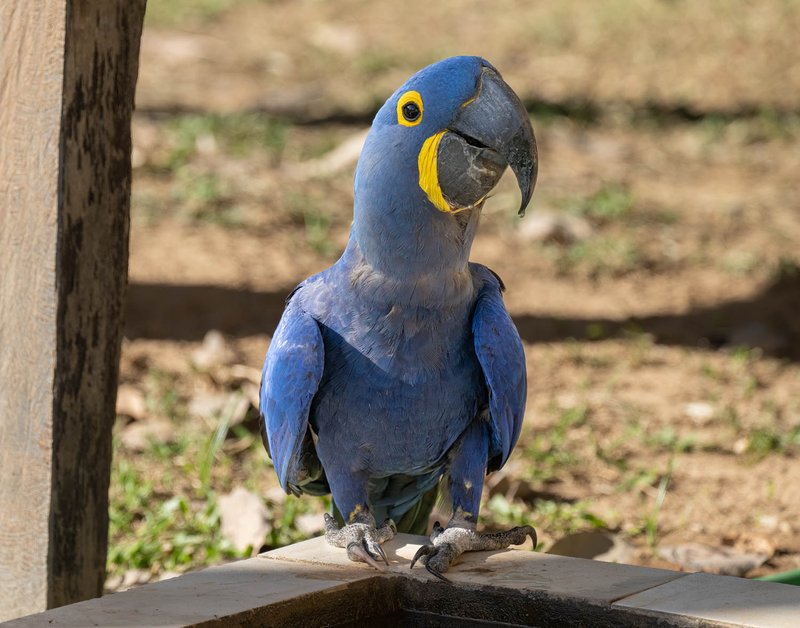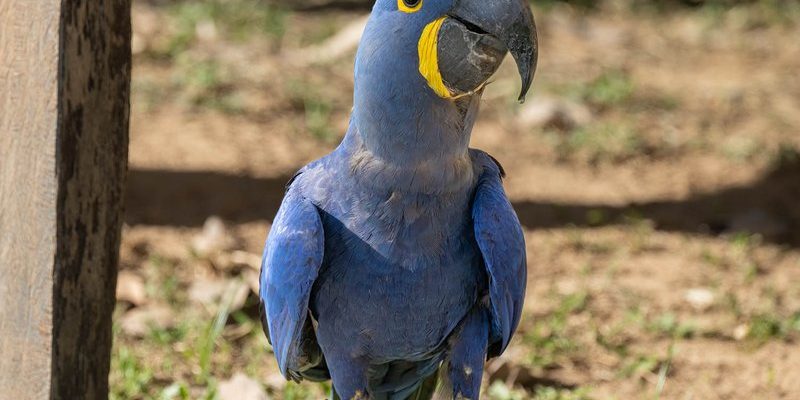
Now, let’s not get too ahead of ourselves. You might be wondering how such a large parrot hunts or forages for food in the wild. Picture a chef skillfully gathering ingredients. The hyacinth macaw does something similar in its natural habitat, but instead of a kitchen, it’s navigating through the lush greenery of South America. Let me explain how these beautiful birds satisfy their cravings and the strategies they use to find food.
The Diet of the Hyacinth Macaw
Hyacinth macaws are known for their seed-heavy diet. They primarily feast on the seeds of palm trees, particularly those from the acuri and babassu palm. These seeds are rich in nutrients, providing the energy these birds need to thrive. It’s like choosing a high-octane fuel for a powerful engine!
One thing to note is how these birds have evolved to crack open even the toughest seeds. They use their strong beaks, which can exert a significant amount of pressure—up to 200 pounds! This ability allows them to access nutrients that many other birds can’t reach. Imagine having a toolbox filled with the right tools for every job; the hyacinth macaw’s beak is its ultimate tool for dining.
It’s not only seeds on the menu, though. Hyacinth macaws also enjoy fruits, nuts, and even flowers. While seeds make up a large part of their diet, these birds are opportunistic feeders, meaning they’ll snack on whatever they can find. You could say they have a bit of a culinary curiosity!
How Hyacinth Macaws Forage
Foraging is a critical skill for hyacinth macaws. They don’t just sit back and wait for food to come to them. Instead, they explore their surroundings with a keen eye. Foraging typically involves these key steps:
- Observation: They scan the area for potential food sources.
- Flight: Using their powerful wings, they glide from tree to tree.
- Investigation: Once they land, they inspect branches and leaves for hidden treats.
You might be picturing them flitting about like a busy chef in a kitchen, constantly checking for the freshest ingredients. This agile foraging style not only helps them find food but also keeps them active and healthy.
Interestingly, hyacinth macaws will often forage in pairs or small groups. This social aspect makes their food-finding mission more efficient. By working together, they can cover more ground and share their findings. Kind of like a potluck dinner where everyone contributes!
The Importance of Palm Trees
Palm trees play a pivotal role in the diet of hyacinth macaws. These trees don’t just offer seeds; they provide a habitat that hosts a variety of food options. In fact, hyacinth macaws are key to the health of palm tree populations. As they crack open seeds, they help disperse them across the forest, aiding in reproduction.
It’s a beautiful cycle of life. The more seeds they consume, the more the palm trees can thrive. In a way, you can think of them as stewards of their environment, ensuring that their food source remains abundant.
The relationship between hyacinth macaws and palm trees is a perfect example of an ecosystem in balance. When these birds have access to healthy palm trees, they flourish. And when palm trees thrive, it supports countless other species in their habitat.
Challenges in Finding Food
While hyacinth macaws have adapted well to their environment, they face challenges in securing food. Habitat loss is a significant issue. As forests are cleared for agriculture or development, these birds find it harder to locate their favorite food sources.
Moreover, over-harvesting of palm nuts can deplete their primary food supply. Imagine walking into a grocery store and finding all your favorite items gone. It’s not just disappointing; it can threaten your health! Similarly, without sustainable practices, hyacinth macaws might struggle to find enough to eat.
Conservation efforts are crucial here. Protecting their habitats and ensuring palm trees remain plentiful is vital for the survival of these incredible birds. Organizations and local communities are working together to raise awareness about the importance of preserving these ecosystems.
Eating Habits and Social Behavior
Hyacinth macaws are not just solitary eaters; they often partake in communal meals. When food is found, it’s common for them to share with other macaws. This social behavior strengthens their bonds and can lead to stronger partnerships for mating.
Their eating habits also include a lot of vocalizations. You might hear them making a variety of sounds while they eat, which can range from soft chirps to loud calls. It’s as if they’re chatting about their meal, creating a lively atmosphere in the treetops!
Interestingly, younger macaws learn foraging skills from older ones. Watching and observing helps them pick up tips on where to find the best seeds or fruits. It’s a bit like learning family recipes that have been passed down through generations.
How To Help Hyacinth Macaws
Want to support these magnificent birds? There are several ways you can contribute to their survival. Here are a few suggestions:
- Support Conservation Groups: Find and contribute to organizations focused on protecting hyacinth macaws and their habitats.
- Spread Awareness: Share information about the importance of preserving tropical ecosystems.
- Responsible Tourism: If you visit areas where these birds live, choose eco-friendly tours that support conservation.
Every little effort counts! Supporting conservation means helping not just hyacinth macaws but a whole web of life that exists in their habitat.
Understanding what hyacinth macaws eat and how they hunt or forage gives us a glimpse into their incredible world. These birds are not only stunning to look at, but they also play a vital role in their ecosystem—just like chefs making careful choices to craft a perfect dish.
As we learn more about them, let’s not forget the importance of protecting their habitats and ensuring their future. By supporting conservation efforts and spreading awareness, we can all help these magnificent birds continue to thrive in the wild. So next time you think of hyacinth macaws, remember, they’re not just beautiful faces—they’re an essential part of the forest’s culinary tapestry!

